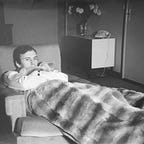La Belle Noiseuse
“Look at me.” — Michel Piccoli, 1991
“Look at me.” — Noemie Merlant, 2019
After a Sunday dinner of spinach quiche, au gratin potatoes, coq au vin, lemon custard cake, and salmon amandine, La Belle Noiseuse was just the film I needed to sit with in order to properly let the stomach acids ferment that feast. As a result, I came to the following conclusion: That La Belle Noiseuse’s prevalence continues to stem from being quite possibly the greatest influence on an equally prolific landmark release in queer and contemporary cinema.
Portrait Of A Lady On Fire’s phenomenality owes a lot to this release, as its use of silence and borderline poetic dialogue makes La Belle Noiseuse the ideal predecessor to capturing the artistic process on film. Its exploration of the meticulous perfectionism held by preset standards that plagues such artists (along with their budding desire to grow out of these standards and into their own identities, be it through self-revelation or the indirect and nuanced impact of the subject) is also what gives this film the kind of credibility that has been long overdue.
Michel Piccoli’s performance is that of a silent beast, one whose hankering for perfection further adds to one of the most captivating careers in cinematic history. His silent strokes have made enough room to send Noemie Merlant running with the same kind of desperation to unravel, subvert, and redefine the heart of a muse in Adele Haenel, whose headstrong resilience echoes a modern reflection of Edouard’s Marianne through Marianne’s Heloise, and vice versa. Emanuelle Beart’s presence needs no explanation, as it exudes that same sense of humanity that is silent but powerful. There’s so much going on in such a simple pose to begin with, which then unfolds into a study of the human body as a reflective vehicle of human expression when art and reality are continually merging into one emotive unit.
So it’s no surprise that 29 years later, this beautiful troublemaker continues to hold itself up with pride. And indeed, what beautiful noise this surely caused to cement itself and its contemporary as two of the greatest celluloid portraits of the starving artist. It is Celine Sciamma who happens to follow in the footsteps of Jacques Rivette, be it unknowingly or not, to create an exceptional document of that same hunger, which is plentiful yet seized by the artist’s pursuits to achieve reflections of their imperfect selves, rooted in pain, yet exuberant in the act of self-discipline through subjects that become the very essence (if not a part) of their singularity.
